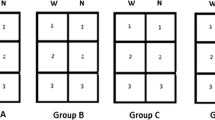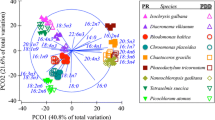Abstract
Algal lipids provide essential fatty acids for higher trophic levels in the marine food web, and understanding the fatty acid composition in phytoplankton is critical for evaluating its value as a diet. Nineteen microalgal species, mainly originating from the Baltic Sea, covering major algal classes were grown in different growth conditions. Samples were taken during both the exponential and stationary growth phases and analysed regarding their fatty acid methyl esters and free fatty acids. Our results show that across all screened species, total fatty acids increased significantly from exponential to stationary growth phase. Furthermore, it was observed that warm-water species contained more lipids and differed in their lipid profile as compared with the cold-water species. Brackish water species also showed a slightly higher lipid content than the marine species, but their lipid profile was not significantly different. Plotting changes in lipids against changes in cell nitrogen revealed a significant dependency between decrease in cell nitrogen and increase in lipids across all tested species.



Similar content being viewed by others
References
Anderson MJ (2001) A new method for non-parametric multivariate analysis of variance. Aust J Ecol 26:32–46
Bligh E, Dyer W (1959) A rapid method of total lipid extraction and purification. Can J Biochem Physiol 37:911–917
Borowitzka MA, Borowitzka LJ (1988) Micro-algal biotechnology. University Press, Cambridge
Budge SM, Parrish CC (1998) Lipid biogeochemistry of plankton, settling matter and sediments in Trinity Bay. Newfoundland. II. Fatty acids. Org Geochem 29(5–7):1547–1559
Chaffin JD, Mishra S, Kuhaneck RM, Heckathorn SA, Bridgeman TB (2012) Environmental controls on growth and lipid content for the freshwater diatom, Fragilaria capucina: a candidate for biofuel production. J Appl Phycol 24(5):1045–1051
Collyer D, Fogg GE (1954) Studies on fat accumulation by algae. J Exp Bot 6(17):256–275
Colombo ML, Rise P, Giavarini F, De Angelis L, Galli C, Bolis CL (2006) Marine macroalgae as sources of polyunsaturated fatty acids. Plant Foods Hum Nutr 61(2):67–72
De Oliveira M, Monteiro MPC, Robbs PG, Leite SGF (1999) Growth and chemical composition of Spirulina maxima and Spirulina platensis biomass at different temperatures. Aquac Int 7(4):261–275
Doyle JJ, Doyle JL (1987) A rapid DNA isolation procedure for small quantities of fresh leaf tissue. Phytochem Bull 19:11–15
Evjemo JO, Tokle N, Vadstein O, Olsen Y (2008) Effect of essential dietary fatty acids on egg production and hatching success of the marine copepod Temora longicornis. J Exp Mar Biol Ecol 365:31–37
Fuentes-Grünewald C, Garcés E, Alacid E, Sampedro N, Rossi S, Camp J (2012) Improvement of lipid production in the marine strains Alexandrium minutum and Heterosigma akashiwo by utilizing abiotic parameters. J Ind Microbiol Biotechnol 39(1):207–216
Guillard R (1975) Culture of phytoplankton for feeding marine invertebrates. In: Smith WL, Chanley MH (eds) Culture of marine invertebrate animals. Plenum Press, New York, pp 26–60
Guillard R, Ryther J (1962) Studies of marine planktonic diatoms. I. Cyclotella nana Hustedt, and Detonula confervacea (Cleve) Gran. Can J Microbiol 8:229–239
Gurr MI, Harwood JL, Frayn KN (2002) Lipid Biochemistry. Lipid biochemistry- An Introduction 5th Edition, Wiley-Blackwell, Oxford
Guschina IA, Harwood JL (2006) Lipids and lipid metabolism in eukaryotic algae. Prog Lipid Res 45(2):160–186
Hällfors G, Hällfors S (1992) The Tvärminne collection of algal cultures. In: Tvärminne Studies, vol 5. University of Helsinki, pp 15–17
Harrison P, Thompson P, Calderwood G (1990) Effects of nutrient and light limitation on the biochemical composition of phytoplankton. J Appl Phycol 2(1):45–56
Harwood JL (1994) Environmental factors which can alter lipid metabolism. Prog Lipid Res 33(1–2):193–202
Harwood JL, Jones AL (1989) Lipid metabolism in algae. Adv Bot Res 16:1–53
Hu Q, Sommerfeld M, Jarvis E, Ghirardi M, Posewitz M, Seibert M, Darzins A (2008) Microalgal triacylglycerols as feedstocks for biofuel production: perspectives and advances. Plant J 54(4):621–639
Kattner G, Gercken G, Eberlein K (1983) Development of lipids during a spring plankton bloom in the northern North Sea: I. Particulate fatty acids. Mar Chem 14(2):149–162
Lane DJ (1991) Nucleic acid techniques in bacterial systematics. Wiley, New York
Larson TR, Rees TAV (1996) Changes in cell composition and lipid metabolism mediated by sodium and nitrogen availability in the marine diatom Phaeodactylum tricornutum (Bacillariophyceae). J Phycol 32(3):388–393
Lee RF, Nevenzel JC, Paffenhöfer GA (1971) Importance of wax esters and other lipids in the marine food chain: phytoplankton and copepods. Mar Biol 9(2):99–108
Lei A, Chen H, Shen G, Hu Z, Chen L, Wang J (2012) Expression of fatty acid synthesis genes and fatty acid accumulation in Haematococcus pluvialis under different stressors. Biotechnol Biofuels 5(1):18
Li Y, Horsman M, Wang B, Wu N, Lan C (2008) Effects of nitrogen sources on cell growth and lipid accumulation of green alga Neochloris oleoabundans. Appl Microbiol Biotechnol 81(4):629–636
Lindqvist K, Lignell R (1997) Intracellular partitioning of 14CO2 in phytoplankton during a growth season in the northern Baltic. Mar Ecol Prog Ser 152:41–50
Lv X, Zou L, Sun B, Wang J, Sun M-Y (2010) Variations in lipid yields and compositions of marine microalgae during cell growth and respiration, and within intracellular structures. J Exp Mar Biol Ecol 391(1–2):73–83
Lynch DV, Thompson GA Jr (1982) Low temperature-induced alterations in the chloroplast and microsomal membranes of Dunaliella salina. Plant Physiol 69(6):1369–1375
Lynch DV, Thompson GA Jr (1984) Chloroplast phospholipid molecular species alterations during low temperature acclimation in Dunaliella. Plant Physiol 74(2):198–203
Mansour MP, Volkman JK, Jackson AE, Blackburn SI (1999) The fatty acid and sterol composition of five marine dinoflagellates. J Phycol 35(4):710–720
Müller-Navarra DC, Brett MT, Liston AM, Goldman CR (2000) A highly unsaturated fatty acid predicts carbon transfer between primary producers and consumers. Nature 403(6765):74–77
Murata N, Wada H (1995) Acryl-lipid desaturases and their importance in the tolerance and acclimatization to cold of cyanobacteria. Biochem J 308:1–8
Pal D, Khozin-Goldberg I, Cohen Z, Boussiba S (2011) The effect of light, salinity, and nitrogen availability on lipid production by Nannochloropsis sp. Appl Microbiol Biotechnol 90(4):1429–1441
Parrish CC, Thompson RJ, Deibel D (2005) Lipid classes and fatty acids in plankton and settling matter during the spring bloom in a cold ocean coastal environment. Mar Ecol Prog Ser 286:57–68
Peterson ME, Daniel RM, Danson MJ, Eisenthal R (2007) The dependence of enzyme activity on temperature: determination and validation of parameters. Biochem J 402:331–337
R Core Team (2012) A language and environment for statistical computing. R Foundation for Statistical Computing. http://www.R-project.org/
Rai H (1995) The influence of photon flux density (PFD) on short term 14C incorporation into proteins, carbohydrates and lipids in freshwater algae. Hydrobiologia 308:51–59
Rai H, Arts MT, Wainman BC, Dockal N, Krambeck HJ (1997) Lipid production in natural phytoplankton communities in a small freshwater Baltic lake, Lake Schöhsee, Germany. Freshw Biol 38:581–590
Reitan KI, Rainuzzo JR, Olsen Y (1994) Effect of nutrition limitation on fatty acid and lipid content of marine microalgae. J Phycol 30(6):972–979
Renaud SM, Thinh L-V, Parry DL (1999) The gross chemical composition and fatty acid composition of 18 species of tropical Australian microalgae for possible use in mariculture. Aquaculture 170(2):147–159
Renaud SM, Thinh LV, Lambrinidis G, Parry DL (2002) Effect of temperature on growth, chemical composition and fatty acid composition of tropical Australian microalgae grown in batch cultures. Aquaculture 211(1–4):195–214
Sakamoto T, Shen GZ, Higashi S, Murata N, Bryant DA (1998) Alteration of low-temperature susceptibility of the cyanobacterium Synechococcus sp. PCC 7002 by genetic manipulation of membrane lipid unsaturation. Arch Microbiol 169(1):20–28
Sheehan J, Dunahay T, Benemann J, Roessler P (1998) A look back at the U.S. Department of Energy’s Aquatic Species Program—Biodiesel from Algae. National Renewable Energy Laboratory
Shields RJ, Bell JG, Luizi FS, Gara B, Bromage NR, Sargent JR (1999) Natural copepods are superior to enriched artemia nauplii as feed for halibut larvae (Hippoglossus hippoglossus) in terms of survival, pigmentation and retinal morphology: relation to dietary essential fatty acids. J Nutr 129(6):1186–1194
Shifrin NS, Chisholm SW (1981) Phytoplankton lipids: Interspecific differences and effects of nitrate, silicate and light-dark cycles. J Phycol 17:374–384
Sivonen K, Himberg K, Luukkainen R, Niemela SI, Poon GK, Codd GA (1989) Preliminary characterization of neurotoxic cyanobacteria blooms and strains from Finland. Toxic Assess 4(3):339–352
Smith REH, Gosselin M, Kattner G, Legendre L, Pesant S (1997) Biosynthesis of macromolecular and lipid classes by phytoplankton in the Northeast Water Polynya. Mar Ecol Prog Ser 147:231–242
Sokal RR, Rohlf FJ (1980) Biometry. W. E. Freeman and Company, New York
Spilling K, Tamminen T, Andersen T, Kremp A (2010) Nutrient kinetics modeled from time series of substrate depletion and growth: dissolved silicate uptake of Baltic Sea spring diatoms. Mar Biol 157:427–436
Spilling K, Brynjólfsdóttir Á, Enss D, Rischer H, Svavarsson HG (2013) The effect of high pH on structural lipids in diatoms. J Appl Phycol. doi:10.1007/s10811-012-9971-5
Suen Y, Hubbard JS, Holzer G, Tornabene TG (1987) Total lipid production of the green alga Nannochloropsis sp. QII under different nitrogen regimes. J Phycol 23:289–296
Takagi M, Karseno, Yoshida T (2006) Effect of salt concentration on intracellular accumulation of lipids and triacylglyceride in marine microalgae Dunaliella cells. J Biosci Bioeng 101(3):223–226
Thompson GA (1996) Lipids and membrane function in green algae. Biochim Biophys Acta 1302(1):17–45
Thompson PA, Guo MX, Harrison PJ, Whyte JNC (1992) Effects of variation in temperature: II. On the fatty acid composition of eight species of marine phytoplankton. J Phycol 28(4):488–497
Tomaselli L, Giovannetti L, Sacchi A, Bochi F (1988) Effects of temperature on growth and biochemical composition in Spirulina platensis strain M2. In: Stadler T, Mellion J, Verdus MC, Karamanos Y, Morvan H, Christian D (eds) Algal Biotechnology. Elsevier Applied Science, London, pp 303–314
Viso A-C, Marty J-C (1993) Fatty acids from 28 marine microalgae. Phytochemistry 34(6):1521–1533
Williams PJL, Laurens LML (2010) Microalgae as biodiesel & biomass feedstocks: review & analysis of the biochemistry, energetics & economics. Energy Environ Sci 3(5):554–590
Yeesang C, Cheirsilp B (2011) Effect of nitrogen, salt, and iron content in the growth medium and light intensity on lipid production by microalgae isolated from freshwater sources in Thailand. Bioresour Technol 102(3):3034–3040
Zchut S, Nir Keren, Ohad I, Uri Pick (2003) Cold-acclimation protects photosystem II against freezing damage in the halotolerant alga Dunaliella salina. J Plant Physiol 160(2):185–192
Zhila NO, Kalacheva GS, Volova TG (2005) Effect of nitrogen limitation on the growth and lipid composition of the green alga Botryococcus braunii Kutz IPPAS H-252. Russ J Plant Physiol 52(3):311–319
Acknowledgments
This study was funded by the Academy of Finland Research Programme “Sustainable energy—SusEn” and the Nordic Energy Research Programme “N-INNER” and MAREX-Exploring Marine Resources for Bioactive Compounds: From Discovery to Sustainable Production and Industrial Applications (Call FP7-KBBE-2009-3, Project nr. 245137). We would like to thank Anke Kremp, Kaarina Sivonen and Seija and Guy Hällfors for providing cultures and Tuulikki Seppänen-Laakso for the development of the lipid extraction and analysing method and helpful discussion about it. The excellent technical assistance of Airi Hyrkäs and Jaana Rikkinen and by the staff of the Tvärminne Zoological Station is gratefully acknowledged. Furthermore, we acknowledge the reviewers for very helpful comments on the manuscript.
Author information
Authors and Affiliations
Corresponding author
Additional information
Handling Editor: Bas W. Ibelings.
Electronic supplementary material
Below is the link to the electronic supplementary material.
Rights and permissions
About this article
Cite this article
Schwenk, D., Seppälä, J., Spilling, K. et al. Lipid content in 19 brackish and marine microalgae: influence of growth phase, salinity and temperature. Aquat Ecol 47, 415–424 (2013). https://doi.org/10.1007/s10452-013-9454-z
Received:
Accepted:
Published:
Issue Date:
DOI: https://doi.org/10.1007/s10452-013-9454-z




